Medical Billing Software Buyer’s Guide 2025
Choosing the right medical billing software is a game changer for your practice. As healthcare changes, it’s important to know what to pay attention to. This buyer’s guide unpacks essential software features, software types, cost factors, and vendor selection tips to help you make an informed decision. You will learn about technology trends that might influence your billing methods, especially how well systems work together and connect. Want to make your medical billing simpler and improve how your practice runs? Let’s dive in!
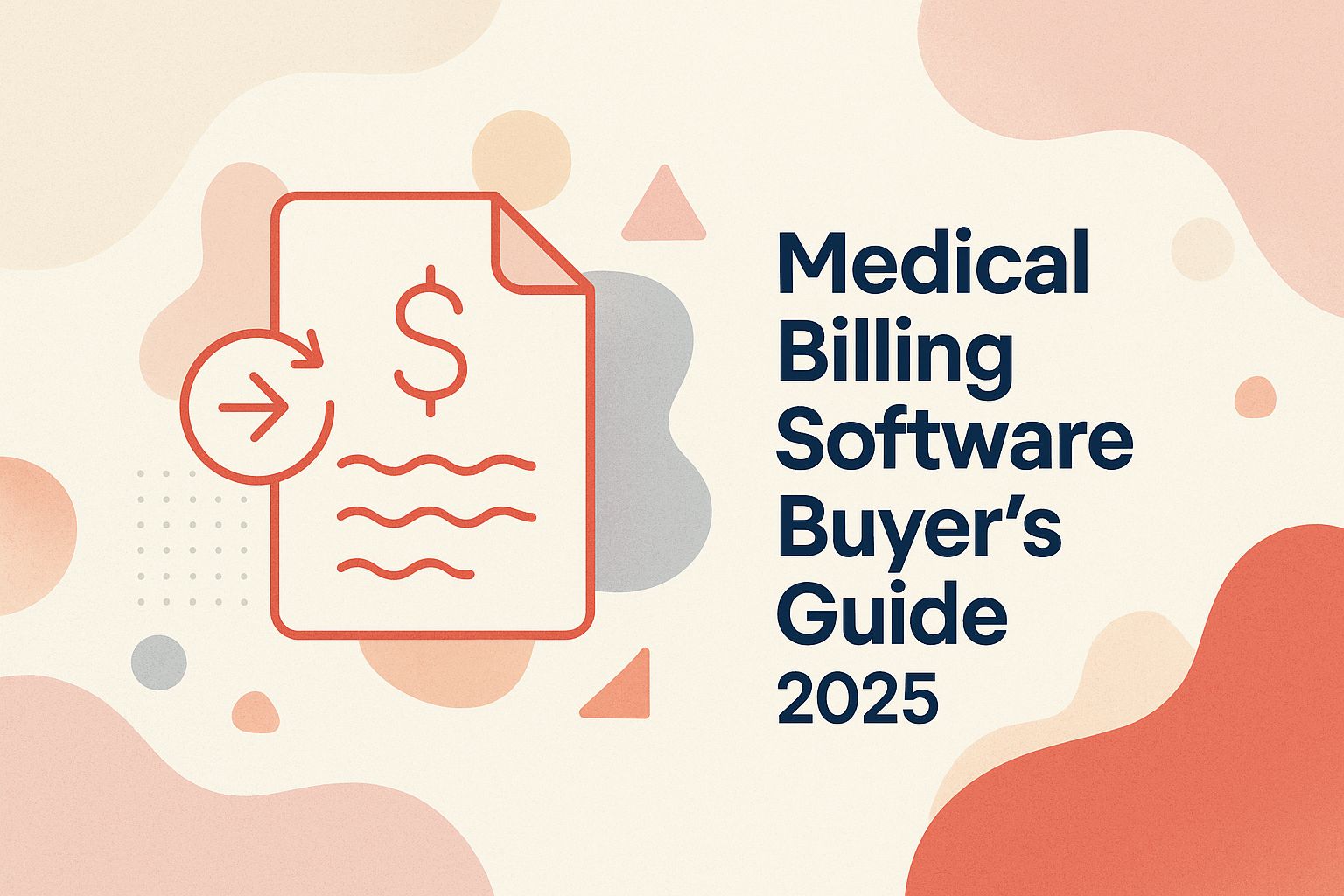
What is Medical Billing Software?
This software category is essential for efficient billing processes and compliance with healthcare regulations.
Medical billing software manages the billing tasks by arranging claims, processing payments, and creating patient invoices. It follows HIPAA rules to keep billing correct and information secure.
Hospitals, clinics, and private practices often use medical billing software to simplify billing tasks and improve how they run day-to-day.
For example, AdvancedMD provides tools for tracking claims and checking eligibility instantly, while Kareo offers easy-to-use interfaces designed for small clinics. NextGen offers strong reporting tools to help with compliance checks.
When healthcare providers choose software that matches their size and needs, they can work more effectively, reduce errors, manage cash flow better, and achieve better return on investment (ROI), saving both time and resources.
Importance of Medical Billing Software in Healthcare
In 2023, healthcare providers using medical billing software report a 30% increase in billing efficiency and a reduction in claim denials by 20%.
The main benefits are from machine-based claims processing, which cuts down on human errors and speeds up payments.
For instance, practices implementing AdvancedMD have seen claim processing times reduced from weeks to days.
Software like Kareo gives instant feedback on billing results, letting providers fix problems right away.
These tools simplify tasks and improve their accuracy, increasing income and allowing staff to concentrate more on patient care, improving the service overall.
Key Features to Look For
Selecting the right medical billing software involves considering key features that affect the efficiency and accuracy of the billing process. To explore a detailed overview of these crucial elements, see also our review on the 10 Important Features to Look For in Medical Billing Systems.
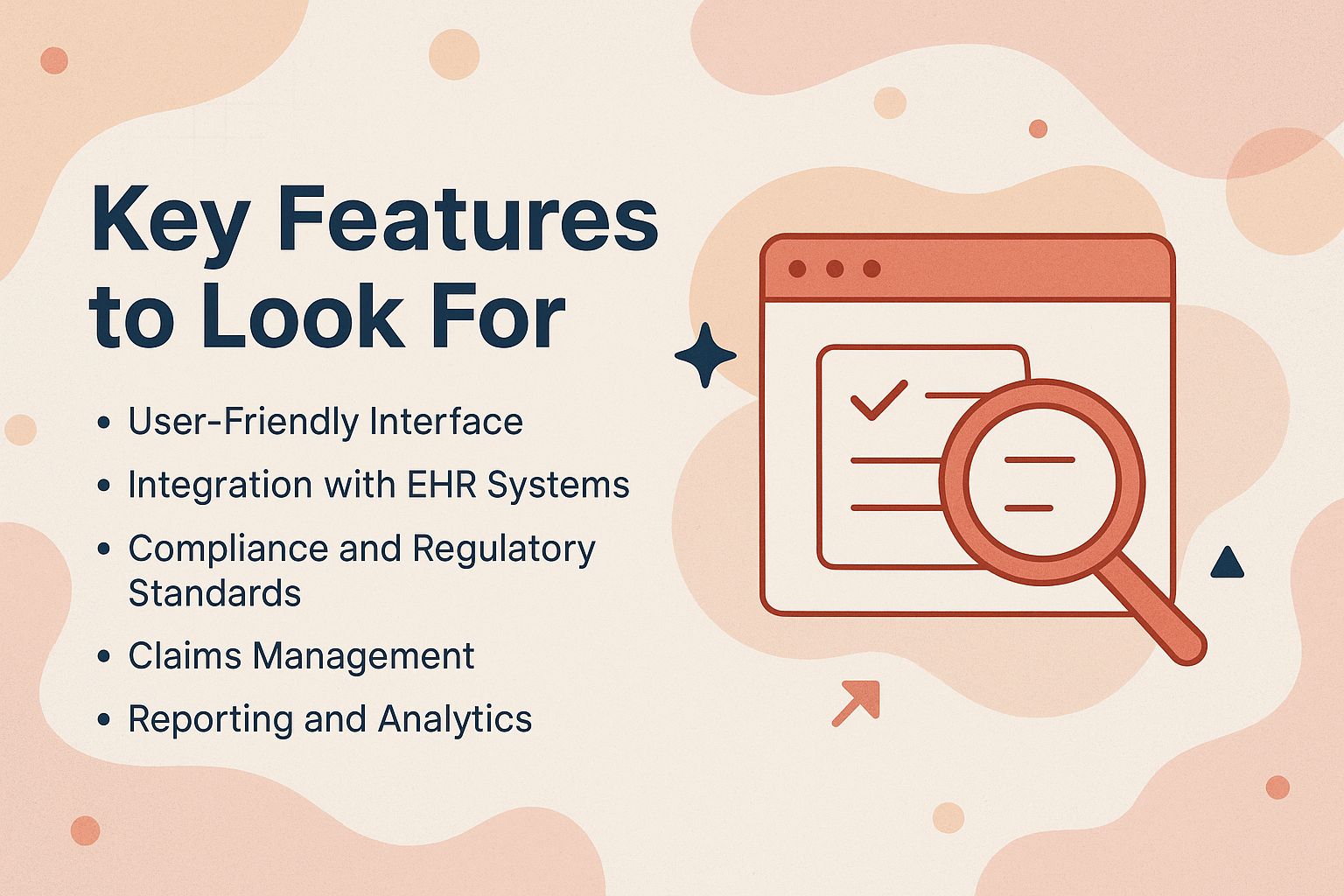
User-Friendly Interface
Improves usability and makes the user experience better.
A user-friendly interface minimizes training time, with software like Kareo allowing users to complete billing tasks in 50% less time than complicated systems.
This effectiveness is due to user-friendly design elements such as clear menus, basic drag-and-drop tools, and accessible dashboards that display important information immediately.
For example, AdvancedMD provides templates that make data entry easier, while PracticeSuite has shortcuts for common tasks.
These systems make processes easier, cutting down on mistakes and allowing staff to concentrate on caring for patients. Using a simple interface changes the billing process, creating a more efficient workplace.
Integration with EHR Systems
Combining EHR systems effectively is essential for sharing information and making workflows better.
Smooth connection with Electronic Health Records (EHR) systems is important, with tools like AdvancedMD allowing data sharing between different systems.
Tools like Epic and Cerner also provide strong connections, which improve data movement and billing correctness. By using APIs, these systems allow for real-time updates and reduce manual data entry errors.
For instance, integration with Epic’s MyChart enables patients to review their billing information seamlessly, improving overall satisfaction. Using middleware tools like Mirth Connect can simplify data exchange between different systems, providing a complete view of patient records.
Implementing these tools can significantly increase operational efficiency and accuracy in billing processes.
Compliance and Regulatory Standards
Following industry standards and healthcare rules is essential.
Medical billing software must comply with stringent regulations, including HIPAA, which governs the handling of patient information.
Compliance features in medical billing software consist of strong encryption for storing and sending data, records to monitor user access and changes, and automatic reporting for insurance claims.
For example, software like Kareo keeps patient information secure, while AdvancedMD provides detailed records to track compliance activities.
Not following these standards can result in heavy penalties, such as fines up to millions of dollars and legal actions, along with harm to a practice’s reputation.
Thus, choosing software that prioritizes compliance is essential for any healthcare provider.
Claims Management
Key for tracking claims and improving revenue cycle management.
Effective claims management can reduce denial rates by 30%, with software like Optum360 enabling real-time tracking and resolution.
Tools such as ClaimShark and DenialSolver provide advanced analytics to identify trends in denials, allowing healthcare providers to adjust their processes proactively. For example, ClaimShark’s AI can point out frequent reasons for denials, aiding teams in solving the main issues.
To better manage claims, hold regular training sessions for staff so they are informed about the latest software updates and effective methods. By combining effective tools with continuous education, organizations can improve their overall claims processing efficiency and revenue cycle metrics.
Reporting and Analytics
Using data analysis to track performance and make decisions.
Advanced reporting and analytics tools allow practices to monitor financial performance, with software such as Athenahealth providing customizable reports.
These tools offer features like real-time dashboards, trend analysis, and forecasting metrics.
For example, with Athenahealth, users can select certain metrics to monitor, such as payments from insurance or past-due accounts, giving a better view of income.
Practices can also integrate tools like Kareo, which allows for visual representation of financial data through graphs, aiding in quick assessments of performance.
These advanced reporting tools help practices find issues and make revenue cycles work better.
Types of Medical Billing Software
Exploring software types like cloud-based solutions, on-premises solutions, and hybrid models.
Deciding on the right medical billing software can impact how smoothly your practice runs. You can choose between software that is hosted online or installed directly on your office computers. For a more comprehensive overview, including comparisons of different software features, discover the best medical billing software of 2025.

Cloud-Based Solutions
Known for being scalable, easy to install, and offering various deployment options.
Cloud-based medical billing solutions, like PracticeSuite, offer flexibility and scalability, with average costs ranging from $150 to $400 monthly.
Users like the convenience of accessing patient information from anywhere, which simplifies billing and lowers mistakes.
For example, software like Kareo simplifies sending claims by handling them automatically and offers an easy-to-use dashboard to monitor payments as they happen.
Many practitioners report time savings of up to 40% with solutions that integrate directly with electronic health records (EHR). These platforms offer affordable and easy access, greatly improving billing processes, which makes them a practical option for many healthcare providers.
On-Premise Solutions
These solutions provide many ways to customize and strong data security.
On-premise medical billing software, such as McKesson, typically requires a higher initial investment, often exceeding $10,000 but offers complete control over data.
Investing in these systems comes with trade-offs. On-premise solutions offer better data protection and compliance, as sensitive patient information stays within the organization’s infrastructure. They offer greater customization to fit specific workflows.
In contrast, cloud options, while often lower in startup costs and maintenance requirements, may introduce dependency on service providers and potential data breaches.
Consider your organization’s initial budget and the need for flexible and scalable choices when selecting the best solution.
Hybrid Models
Hybrid models provide a balance of cloud convenience with on-premise control and scalability.
Hybrid billing solutions combine elements of cloud and on-premise systems, providing flexibility at a moderate cost, usually around $300-$600 monthly.
These systems are known for being flexible and able to grow easily. For instance, software like AdvancedMD allows users to access patient records remotely, yet retains essential local processing capabilities for compliance.
NextGen Healthcare offers a program that brings together billing and EHR, simplifying data transfer. While hybrid models offer more flexibility, they can also lead to problems like harder data management and possible integration issues.
Regular training and good IT support are essential to overcome these challenges and get the most out of hybrid billing.
Cost Considerations
Evaluating if costs are worth the benefits and possible profits is important.
Knowing how much medical billing software costs is important. For a detailed breakdown of these costs, explore our insights on Breaking Down Medical Billing Software Costs.
Prices can vary, starting at $150 per month for simple online options, and going above $10,000 for strong systems installed on-site.
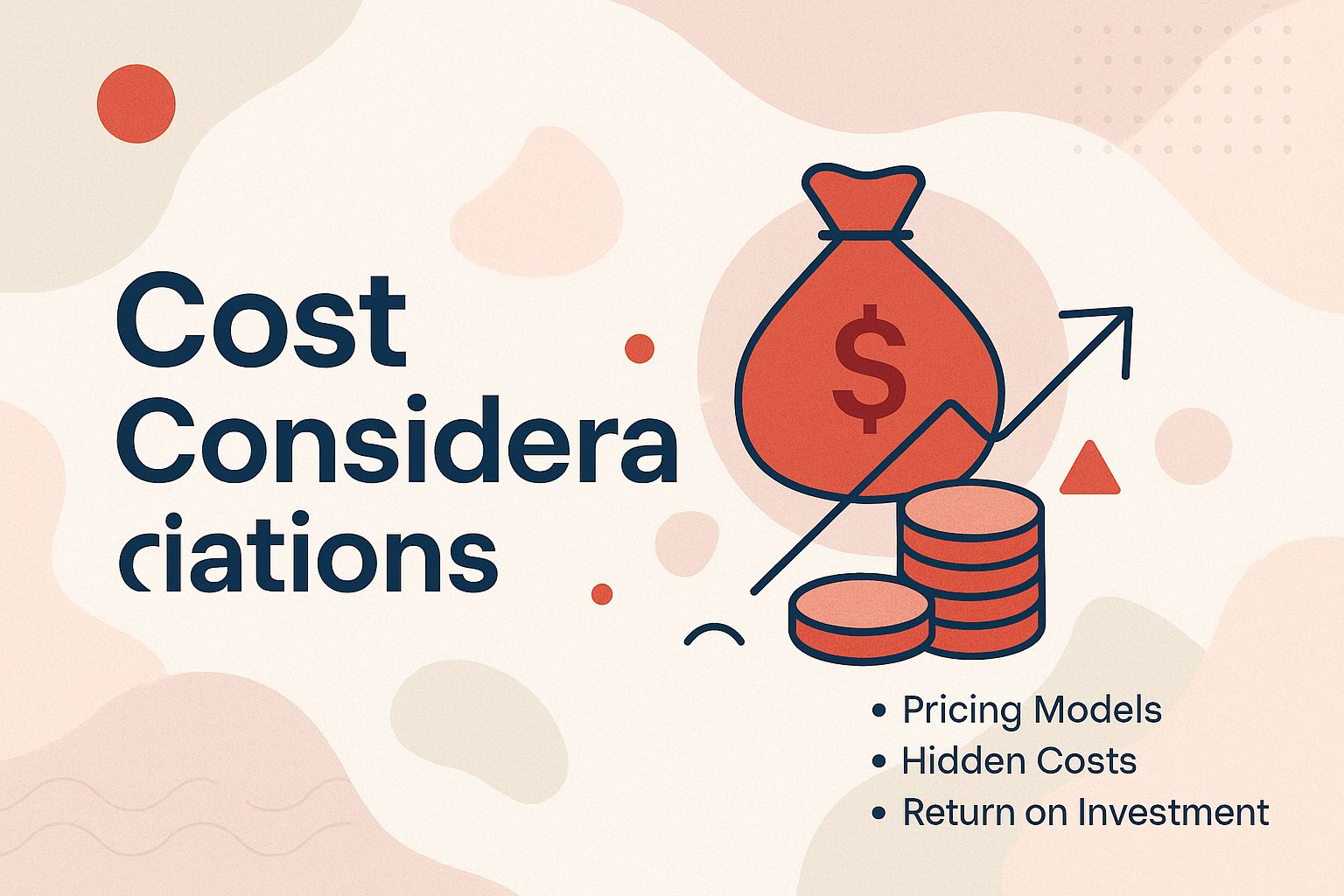
Pricing Models
Knowing how pricing works, like subscription or per-claim fees, helps in making smarter investment choices.
Pricing models for medical billing software typically include subscription-based, per-claim fees, or one-time purchase options, with subscription costs averaging $300/month.
In subscription-based models, popular software like Kareo charges around $150-$500 monthly, depending on features.
Services like AdvancedMD usually charge between $1 to $5 for each claim they process.
Alternatively, one-time purchase options, like Medisoft, may have an initial fee of $800, but could incur additional costs for upgrades.
Organizations should assess patient volume and feature requirements to choose the ideal model that balances upfront costs with ongoing expenses.
Hidden Costs
Beware of hidden costs that affect overall investment and ROI analysis.
Hidden costs, such as training fees, data migration expenses, and maintenance charges, can inflate the overall price of medical billing software by up to 30%.
To budget effectively for these expenses, start by requesting a detailed quote from the software provider, specifying potential hidden costs.
For instance, inquire about training fees, which can range from $500 to $2,000 per team member.
Evaluate data migration fees-some software vendors may charge extra for transferring existing records, typically between $1,000 and $5,000. Consider comparing different software categories to find the best fit.
Don’t forget about ongoing software maintenance costs, as these can average around 20% of the software’s yearly licensing fee. Reviewing system requirements and compatibility can help manage these expenses.
By thinking about these points, including implementation time and software reliability, you can make a more exact budget and steer clear of surprise costs.
Return on Investment (ROI)
Practices using modern billing software report an average ROI of 150% within the first year due to reduced overhead and improved claims processing, highlighting the importance of ROI analysis and EHR integration.
To effectively analyze ROI, track key metrics such as reduced days in accounts receivable (AR), claim rejection rates, and operational costs.
For instance, one practice using AdvancedMD saw a 30% decrease in AR days and a 20% reduction in claim denials, translating into significant revenue recovery.
Tools like Revenue Cycle Analytics can help in monitoring these metrics. Benchmark your practice against industry standards to set realistic goals and drive improvements.
Regular checks of these factors help maintain long-term ROI and find ways to improve.
Vendor Selection Criteria
Picking a company for medical billing software needs careful thought about important factors to find the right match for your practice. By considering these key aspects, you can effectively navigate your choices and make a more informed decision. For more insights, explore our 11 tips for buying medical billing software to ensure you choose the best option for your needs.
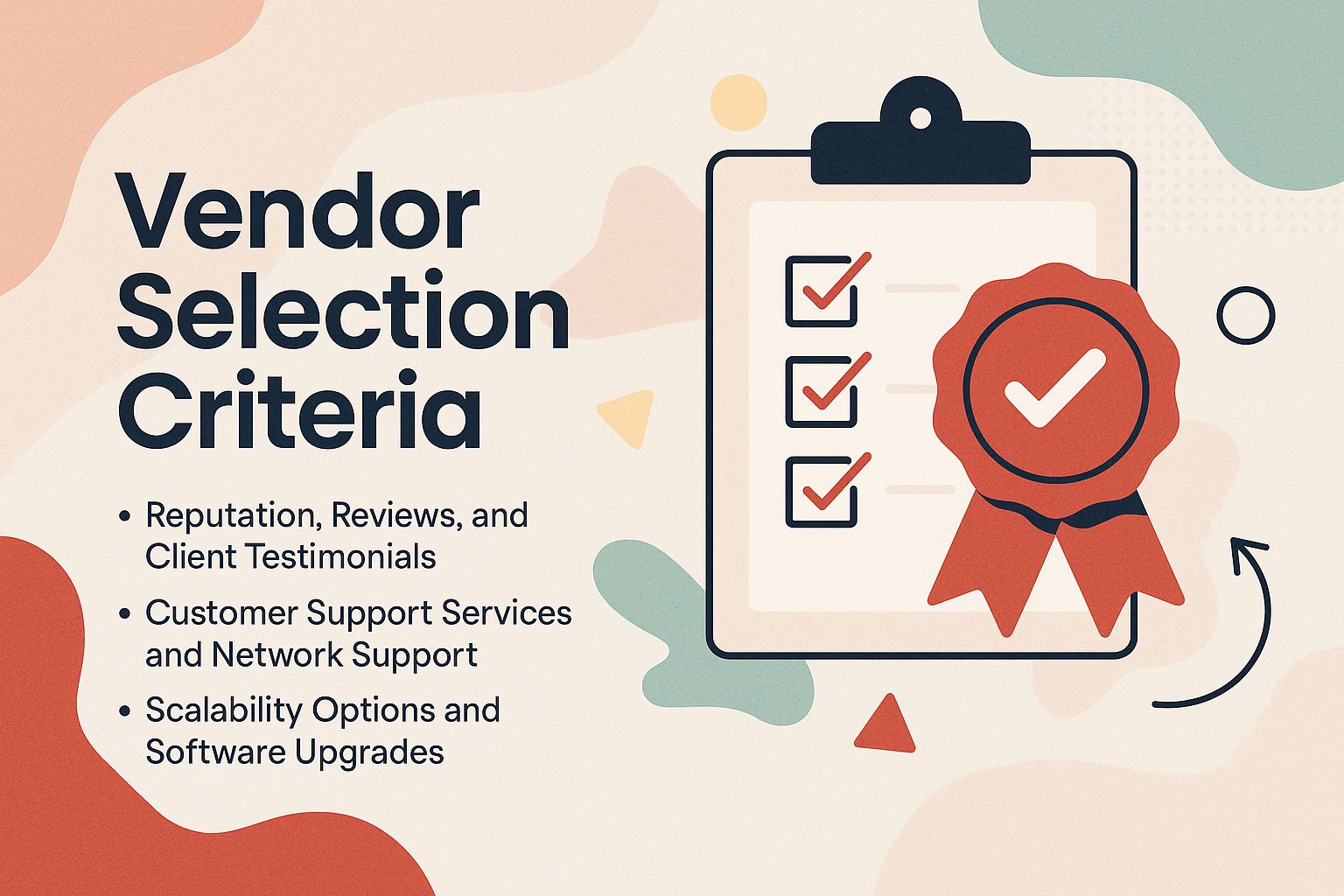
Reputation, Reviews, and Client Testimonials
Research shows that 75% of healthcare providers prioritize vendor reputation, often relying on platforms like G2 and Capterra for user reviews.
To assess vendor reputation effectively, start by examining user reviews on those platforms. Notice consistent trends in customer comments, both positive and negative, and consider market research to understand the situation fully.
Use tools like Trustpilot or Google Reviews to gather a wider range of opinions. For a detailed look, think about joining industry-specific solutions forums or LinkedIn groups where professionals discuss their experiences.
Getting this feedback informs your choice and helps spot possible problems or notable qualities of various vendors.
Customer Support Services and Network Support
Having strong customer support is important, as many successful businesses solve problems more quickly when they work with vendors that offer 24/7 support.
For instance, companies like AdvancedMD and Kareo are known for their exceptional customer service, featuring dedicated support teams available around the clock. This availability can significantly reduce downtime during critical billing periods.
Practices using these software tools often report faster claim processing and better work processes. Linking Zendesk with billing software helps manage support queries, allowing practices to log and address problems as they arise. This improves communication and speeds up solving issues.
Scalability Options and Software Upgrades
Billing software with scalability options allows it to expand alongside your practice, which is important for 60% of healthcare businesses that are expanding.
This flexibility is important because practices might grow their services or open new locations.
For example, solutions like Kareo and AdvancedMD allow seamless transitions from small to large operations by adding users and functionality as needed, ensuring customer retention and account management efficiency.
Adjustments can include integrating new specialties or adding telehealth features.
PracticeSuite provides flexible billing processes that fit different payment models, allowing practices to update without needing to switch their main software.
By choosing software that can grow with them, businesses prepare for success and reduce possible issues during changes.
Implementation Process and Strategies
Setting up medical billing software involves a clear plan and training, which are important steps for a smooth changeover.
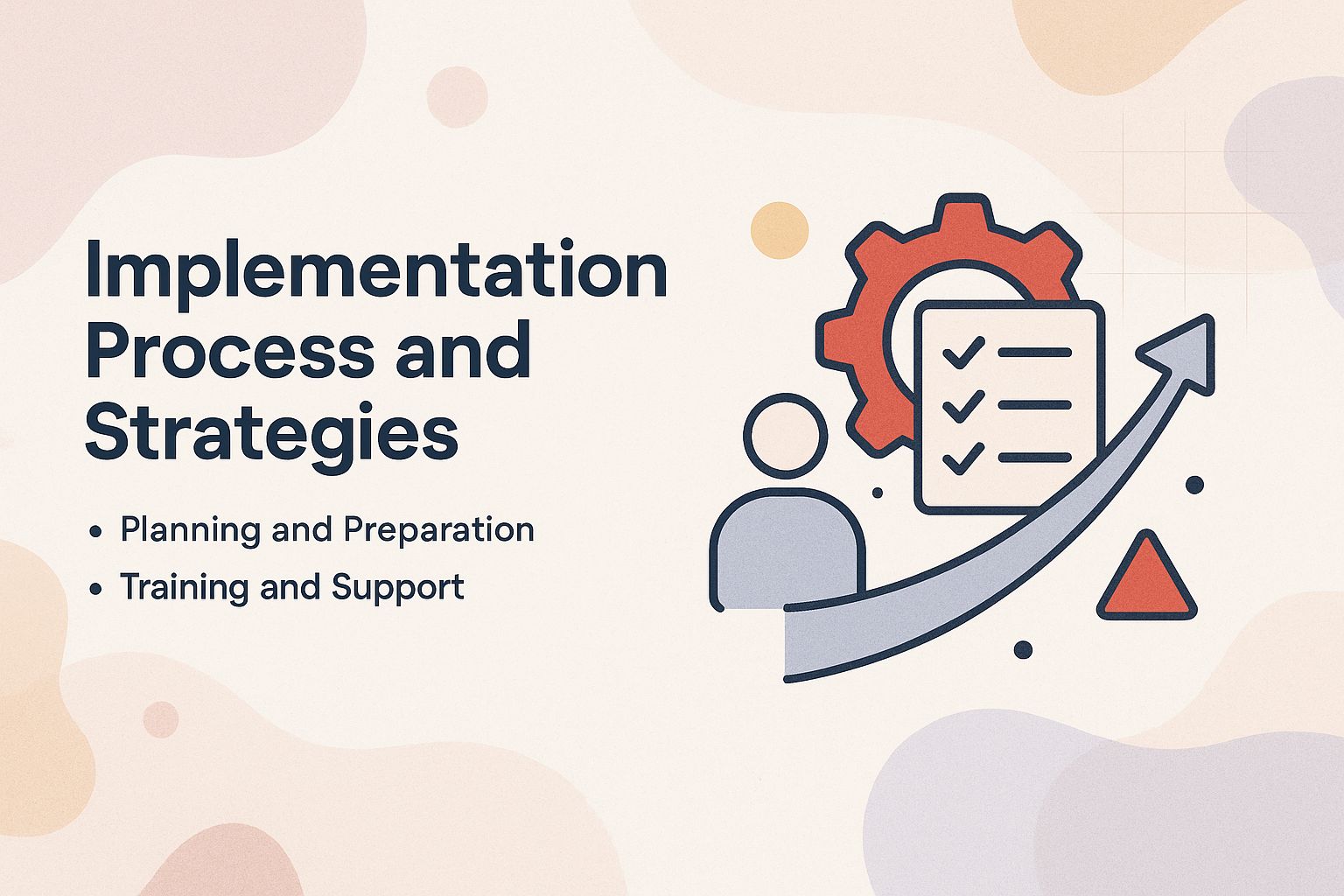
Planning and Preparation
Careful planning for software use can reduce the changeover time by up to 40%, with clear goals outlined before starting.
Begin by defining specific goals that align with business objectives, such as improving efficiency or reducing costs. Next, establish a realistic timeline, incorporating key milestones that allow for assessment of progress.
Include stakeholders, such as IT and end-users, early in the process to gather opinions and secure agreement. Tools such as Trello or Asana can help arrange tasks and keep everyone on track.
This organized method clears up what is expected and encourages working together, resulting in easier execution and improved end-user satisfaction.
Training and Support
Training programs that cost between $1,000 and $3,000 are necessary to teach employees how to use the new billing software properly.
These programs focus on both the technical parts of the software and practical use through hands-on exercises and examples from real life.
For instance, utilizing a train-the-trainer approach can create internal champions, reducing long-term training costs.
Incorporating online resources such as video tutorials and webinars can facilitate ongoing support at little to no additional expense.
Setting aside funds for a yearly workshop to update skills can improve staff competence and confidence, helping them adjust more easily and effectively to the new system, ensuring smooth client onboarding and compatibility with new technologies.
Upcoming Developments in Medical Billing Software
Emerging trends in medical billing software, including AI-driven automation and tele-health billing solutions, are set to reshape healthcare practices by 2025, impacting software comparison and market trends.
These trends will improve practice management by simplifying billing procedures, which will make them more efficient.
For instance, AI-driven automation can reduce manual entry errors by up to 70%, saving time and costs.
Similarly, tele-health billing solutions will allow practices to easily integrate virtual visits into their financial systems, accommodating both in-person and remote care seamlessly.
By using these technologies early, practices might experience improved cash flow, better features, and more satisfied patients, which can help them stay competitive in a rapidly changing healthcare industry. For those wanting to compare these advancements and explore other options, our review of the Best Medical Billing Software of 2025 might be quite beneficial.
Author: Mike Cynar
Mike Cynar brings buyers and sellers together by producing reviews and creating non biased webpages allowing users to share their experiences on various products and services. He and his staff write informative articles related to the medical field, legal, and other small business industries.
Leave a Reply